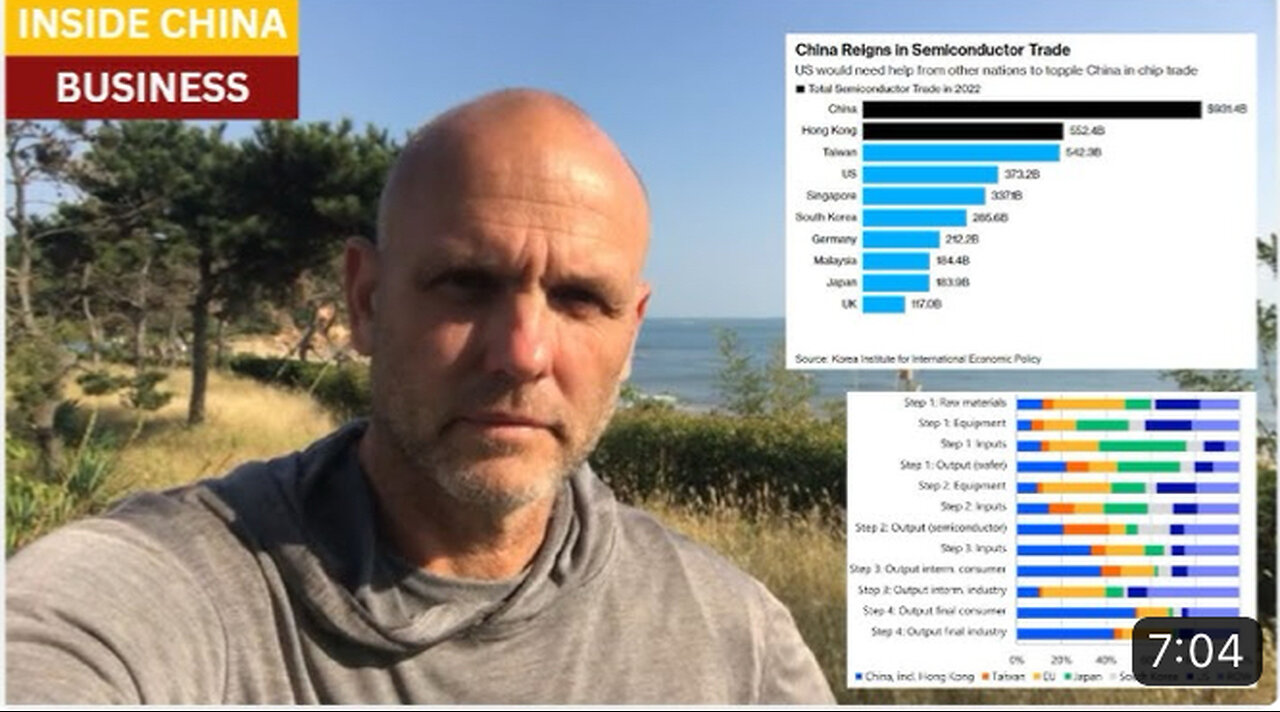Premium Only Content

Two problems in the Chip War:
Video: Two problems in the Chip War: we need China to build semiconductors, and we need China to buy them 晶片戰爭的兩個問題:我們需要中國製造半導體,我們需要中國購買半導體
https://www.bloomberg.com/news/articles/2024-04-02/us-asks-south-korea-to-toughen-up-export-controls-on-china-chips
https://www.japantimes.co.jp/business/2024/09/02/tech/south-korea-us-china-chip/
https://waferpro.com/chinas-dominance-in-the-global-silicon-supply/
https://m.koreatimes.co.kr/pages/article.asp?newsIdx=383248
https://www.bloomberg.com/news/articles/2024-09-02/china-warns-japan-of-retaliation-over-potential-new-chip-curbs
https://www.rabobank.com/knowledge/d011371771-mapping-global-supply-chains-the-case-of-semiconductors
Korean tech companies are examples of the issues we face in our semiconductor export bans with China. China is dominant in key chokepoints of the supply chain, especially high-grade polysilicon and wafers, and certain rare earth elements necessary for the production of the newest-generation chips.
Korean firms also are heavily exposed by their own factory production, which is concentrated in China for the manufacture of intermediate components.
Most of all, though, is the chips firms' reliance on China as a sales channel. China is by far the biggest buyer of semiconductors, and the rest of the world simply cannot replace Chinese firms as buyers. So to comply with US and EU demands for further chip restrictions is to imperil the survival of our own companies.
韓國科技公司就是我們在對華半導體出口禁令中所面臨的問題的例子。 中國在供應鏈的關鍵節點上佔據主導地位,尤其是高品級多晶矽和矽片,以及生產最新一代晶片所需的某些稀土元素。
韓國企業也因自己的工廠生產而受到嚴重影響,這些工廠生產集中在中國,用於製造中間零件。
不過,最重要的是晶片公司對中國作為銷售管道的依賴。 中國是迄今為止最大的半導體買家,世界其他國家根本無法取代中國企業成為買家。 因此,遵守美國和歐盟進一步限制晶片的要求就會危及我們自己公司的生存。
-
 LIVE
LIVE
TimcastIRL
1 hour agoDemocrats SHUT DOWN Congress Blocking Censure Of Al Green, OBSTRUCT House w/Joe Redden | Timcast IRL
19,242 watching -
 1:03:27
1:03:27
Glenn Greenwald
5 hours agoUK Pressures Apple to Break Encryption in Major Privacy Clash; How Dems Can Win Back the Working Class: With Former Bernie Sanders Campaign Manager Faiz Shakir | SYSTEM UPDATE #419
30.3K34 -
 47:39
47:39
Michael Franzese
3 hours agoJewelry King Trax NYC EXPOSES How the Powerful Steal from You
32.6K7 -
 LIVE
LIVE
Slightly Offensive
3 hours agoCandace REDPILLS the Masses in BOMBSHELL Theo Von Interview | Guest: Shane Cashman
1,101 watching -
 LIVE
LIVE
megimu32
2 hours agoON THE SUBJECT: IRL Streamers Attacked & Nostalgic Animal Movies That Made Us Cry
332 watching -
 1:00:54
1:00:54
The Tom Renz Show
6 hours agoMore Epstein/FBI, a Scary Trade War, & the Dem Echo Chamber
829 -
 40:43
40:43
Kimberly Guilfoyle
7 hours agoDems Double Down on Delusion-Why? Live with Tony Kinnett & Bo French | Ep.202
61.7K30 -
 1:28:42
1:28:42
Redacted News
5 hours agoBREAKING! SOMETHING BIG IS HAPPENING IN EUROPE ALL OUT WAR IS COMING AGAINST RUSSIA, TRUMP FURIOUS
108K260 -
 47:50
47:50
Candace Show Podcast
6 hours agoBREAKING: Judge Makes Statement Regarding Taylor Swift's Text Messages. | Candace Ep 155
94.3K104 -
 DVR
DVR
Josh Pate's College Football Show
2 hours agoCFB’s Most Hated Teams | FSU & Clemson Future | Big Ten Win Totals | Star Rankings Overrated?
5.76K